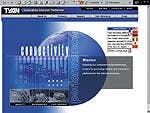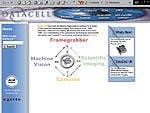Wilson's Websites
With the driving product-design forces of decreasing time to market and reducing cost, nearly all of today's frame-grabber, image-processing, and DSP-related add-in boards are PCI-based. As a 32-bit, 33-MHz standard, the PCI bus has long been used to develop add-in products. Now, however, with increasing demand for faster system speed, the bus is slowly giving way to faster PCI 2.2, 64-bit, 66-MHz implementations and even 64-bit, 133-MHz PCI-X versions. This month, we look at the latest PCI technology and some OEM boards that are taking advantage of the increased bandwidth.
HIGH-SPEED MOTHERBOARDSwww.tyan.comTyan (Fremont, CA) focuses on designing, manufacturing, and marketing high-end system boards. The company's Web site provides descriptions of its Thunder HEsl (S2567) and Thunder LE-T (S2518) motherboards. The HEsl board supports up to two Intel Pentium III processors, four DIMM sockets that can store up to 4 Gbytes, and 64-bit, 66-MHz, and 64/32-bit 33-MHz PCI expansion slots. The LE-T board supports up to two Intel Pentium III processors, an integrated LAN, 2-D/3-D graphics controllers, and two 64-bit, 66-MHz PCI expansion slots.
FAST GRABBINGwww.datacell.comWith an on-board 36-bit LVDS digital interface, the Phoenix PCI-based frame-grabber series from DataCell (North Billerica, MA) combines a scalable DMA engine, support for both 32-bit/33-MHz and 64-bit, 66-MHz PCI capabilities, multiple-tap cameras, and multiple boards. This site also features the company's earlier Snapper frame-grabber series, as well as camera, developer, and applications support information.
DISPLAY CONTROLwww.dome.comDome Imaging Systems (Waltham, MA) was one of the first companies to debut a 64-bit, 66-MHz PCI-based display controller board. Now, the company offers a number of boards, primarily aimed at medical image-processing applications, that feature the high-speed bus. On this Web site, you'll find complete specifications for these products, the latest radiology links, and company articles and press releases.
MEDICAL APPLICATIONSwww.terarecon.comTeraRecon (San Mateo, CA) is an imaging-technology company that develops systems and subsystems for medical, geophysical, industrial, and scientific markets. VolumePro 1000, a second-generation 3-D rendering accelerator, furnishes up to 2 Gytes of on-board memory for loading large datasets. In addition to detailing this and other company products, this site offers articles on medical, nondestructive-testing, industrial, and ultrasound applications.
GOING FASTERwww.compaq.com/products/servers/technology/pci-x-enablement.htmlA compatible extension of the existing PCI bus, the 64-bit, PCI-X architecture runs at speeds up to 133 MHz and delivers burst transfer rates greater than 1 Gbyte/s. On this Web site from Compaq Computer (Dallas, TX), there is a wealth of information on this standard, including FAQs, technology briefs, architectural overviews, PCI-X tutorials, and product information on the company's range of PCI-X-enabled servers.
LOTS OF PRODUCTSwww.eg3.comThe eg3.com (Newark, CA) site showcases embedded systems, DSPs, real-time operating systems, and board-level computing products. By displaying sections of this site as they are relevant to specific buses, such as PC/104, PCI, and VME, for example, users can quickly locate signal-processing, image-processing, and other I/O boards with which to build a system.



